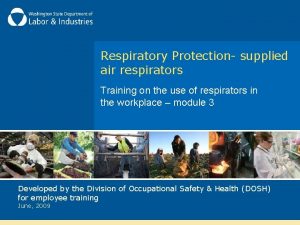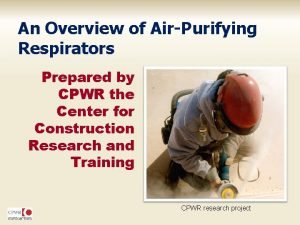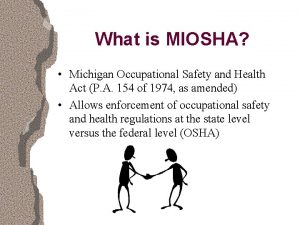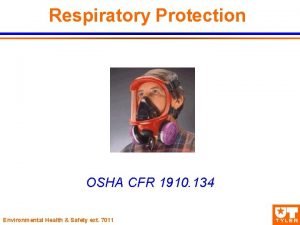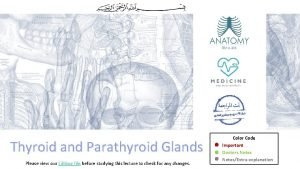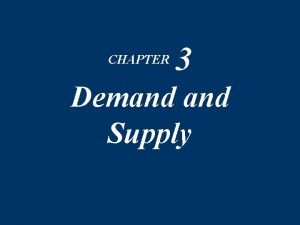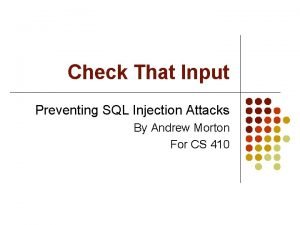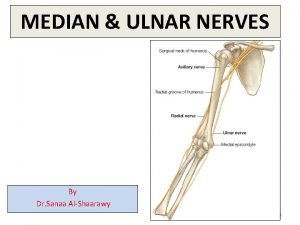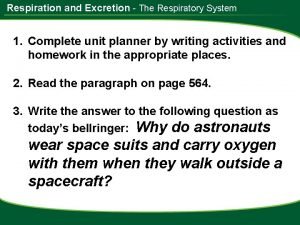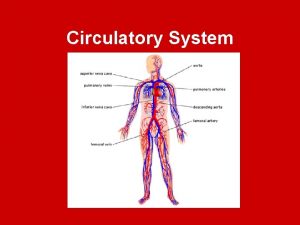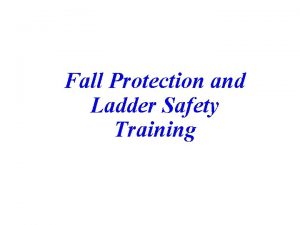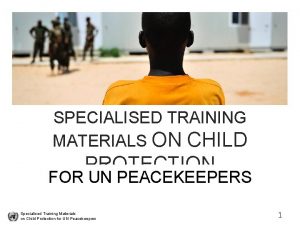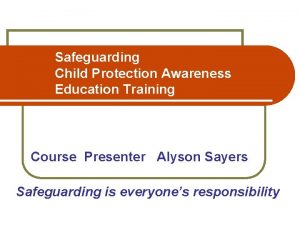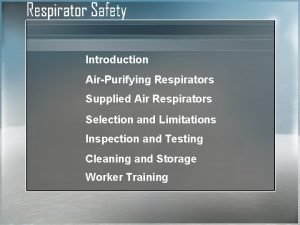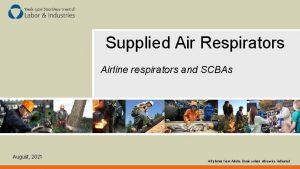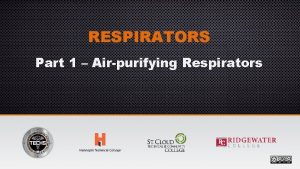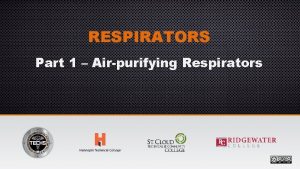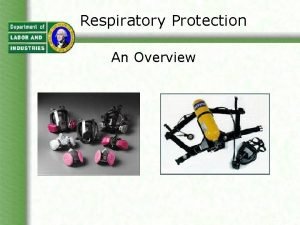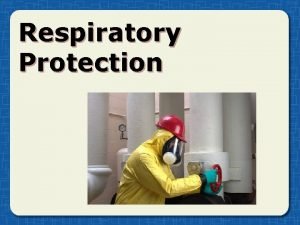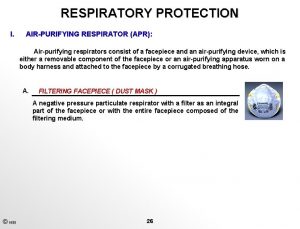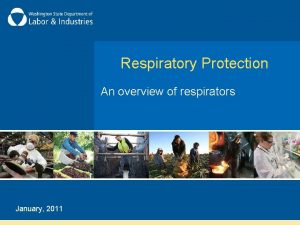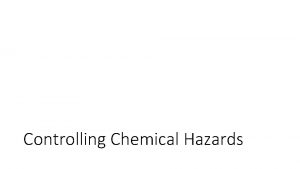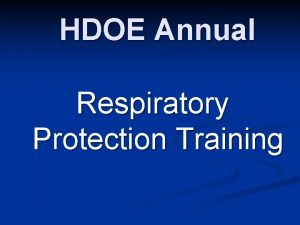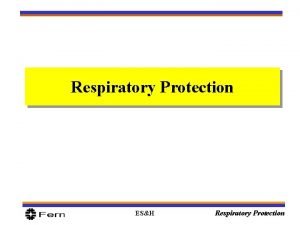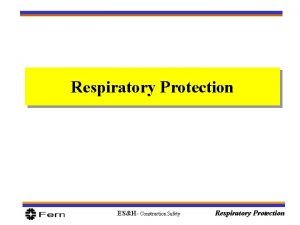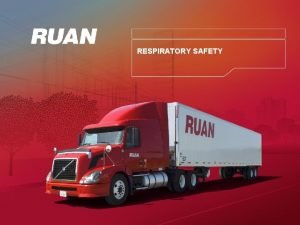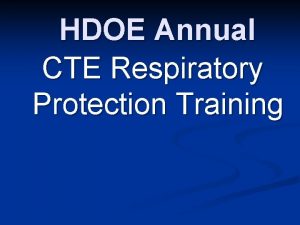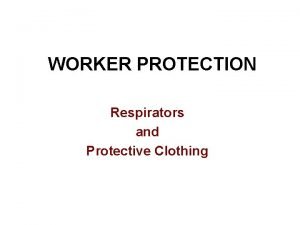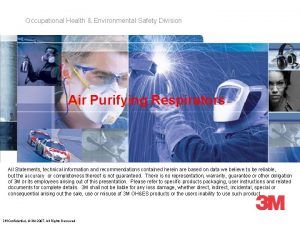Respiratory Protection supplied air respirators Training on the




![Respirator Program Administrator Our respirator administrator is [name] This person is responsible for overseeing Respirator Program Administrator Our respirator administrator is [name] This person is responsible for overseeing](https://slidetodoc.com/presentation_image/27c2de451a28e7c8a65b349338dda381/image-5.jpg)






















![Compressors We Use [Discuss compressors you use here] 28 Compressors We Use [Discuss compressors you use here] 28](https://slidetodoc.com/presentation_image/27c2de451a28e7c8a65b349338dda381/image-28.jpg)
![Storage and Maintenance Airline Respirators Store facepiece and regulator in clean, dry place. [location] Storage and Maintenance Airline Respirators Store facepiece and regulator in clean, dry place. [location]](https://slidetodoc.com/presentation_image/27c2de451a28e7c8a65b349338dda381/image-29.jpg)

- Slides: 30

Respiratory Protection- supplied air respirators Training on the use of respirators in the workplace – module 3 Developed by the Division of Occupational Safety & Health (DOSH) for employee training June, 2009

Supplied Air Respirators – Module 3 Airline Respirators & SCBAs 2

Training Notes This module is introductory training for employees who wear supplied air respirators. The two main types of supplied air respirators are covered in this module. Abrasive blasting hoods or re-breather type respirators are not covered. This module only covers basic facts of supplied air respirators and is not complete training by itself. Employees must also be given hands-on training with the respiratory equipment they will use. 3

Why Is This Training Required? Training is required by WISHA for anyone who wears a respirator. We also are providing this training so you will know how to protect your health. If you don’t know how to use a respirator properly, you can get a false sense of protection. 4
![Respirator Program Administrator Our respirator administrator is name This person is responsible for overseeing Respirator Program Administrator Our respirator administrator is [name] This person is responsible for overseeing](https://slidetodoc.com/presentation_image/27c2de451a28e7c8a65b349338dda381/image-5.jpg)
Respirator Program Administrator Our respirator administrator is [name] This person is responsible for overseeing our respirator program. This person has training on respirators. 5

What are supplied air respirators? Two Types Airline respirator – air from a compressor SCBA (self-contained breathing apparatus) – air from a tank 6

Typical Examples of Use Sandblasting Chemical leak or spill response Firefighting 7 Confined space work

Where we use supplied air respirators We use supplied air respirators in the following locations, jobs or situations: 8

Supplied-air respirators are required for protection in cases of: ü Oxygen deficiency ü High levels of toxic chemicals in the air – above “IDLH” levels ü Other conditions of high levels of highly toxic chemicals in the air ü Firefighting 9

What is Oxygen Deficiency? An oxygen deficiency can be life-threatening Normal air contains 21% oxygen. A space with oxygen content below 19. 5% is “oxygen deficient”. Lack of oxygen cause immediate collapse and death. Oxygen deficiency can occur in confined or enclosed spaces or areas of large chemical leaks. 21% 19. 5% 0% Oxygen content Oxygen deficiency exists 10

Effects of Oxygen Deficiency % Oxygen Symptoms 19. 5% - 16% Fatigue, mild impaired coordination 16% - 12% Increased breathing rate and pulse; impaired coordination, perception or judgment 12% - 10% Further increased breathing rate, blue lips, mental confusion 10% - 8% Fainting, nausea, vomiting, mental confusion within minutes, collapse 8% - 6% Collapse, death within 8 minutes 6% - 0% Coma within 40 seconds, death 11

What is “IDLH”? Immediately Dangerous to Life or Health “IDLH” means immediately dangerous to life or health Many chemicals have a listed IDLH level link to NIOSH IDLH Table Oxygen deficiency is also IDLH conditions can occur in confined spaces, large chemical spills or leaks and fires 12

Entering an IDLH Atmosphere Several safeguards must be used to enter an area with IDLH conditions: ü Must have at least one or two standby persons at entrance. ü Standby employees must be trained to conduct emergency rescue. ü Appropriate retrieval equipment may be needed. 13

Example of IDLH - Hydrogen Sulfide (H 2 S) Hydrogen sulfide gas is commonly found in sewers. It can be instantly fatal at higher levels in a confined space. IDLH level is 100 ppm. Disturbing sewage sludge can release more hydrogen sulfide gas. Supplied air respirators are normally needed to enter sewers. 30 100 200 600 1000 2000 H 2 S in parts per million (ppm) Smell strong odor Loss of smell Coughing, red eyes Unconscious in 30 min. Instant collapse 14 Death in minutes

Escaping an IDLH Atmosphere In IDLH conditions, a worker may need to escape or immediately leave the area. An SCBA allows escape at any time. Airline respirators need a small escape bottle of air attached at the waist. Airline respirator with emergency escape cylinder 15

Escape-only Respirators Escape-only respirators can be used in situations where chemical releases might occur, but the air is normally uncontaminated. Escape bottle attached to airline respirator system Carried escape respirator 16

Respirator Air Pressure Demand vs. Demand Air pressure inside the respirator facepiece is controlled by the respirator regulator. “Pressure-demand” means air flows into the facepiece as needed, but the facepiece is always positivelypressured. “Demand” means air flows into the facepiece only when you inhale. Only pressure-demand can be used in IDLH conditions. 17

Air Flow in Supplied Air Respirators Continuous flow airline respirators “Continuous flow” means air is constantly blowing into the respirator facepiece. Continuous flow is found in loose-fitting airline respirators. This type is often more comfortable and hoods can be worn over a beard. Loose-fitting hood This type cannot be used in IDLH conditions. 18 Loose-fitting facepiece

Supplied Air Respirator Selection Conditions Type of Respirator IDLH conditions or oxygen deficiency SCBA or airline with escape bottle Dust/chemical levels up to 1000 times PEL Airline with tight-fitting full facepiece or full hood Dust/chemical levels up to 50 times PEL Airline with tight-fitting half facepiece Dust/chemical levels up to 25 times PEL Airline with loose facepiece PEL = permissible exposure limit 19

Airline Respirator Advantages & Limitations Advantages – ü continuous air supply, ü lightweight, ü less maintenance, ü don’t need to buy tank air Limitations- ü tied to a 300 ft. hose, ü depends on output of compressor, ü need an attached escape bottle in IDLH conditions 20

SCBA Advantages & Limitations Advantages ü highest form of protection, ü can be used anywhere, ü allows unrestricted mobility Limitations ü heavy & bulky, ü limited air supply(30 - 60 min. ), ü extensive training required, ü high maintenance 21

Using SCBAs – Special Notes SCBAs are sophisticated respirator equipment used for possible or actual life-threatening situations. SCBAs should not be used without extensive hands-on training and frequent re-training. Most SCBA manufacturers or distributors provide this training. If you have large chemical spill or leak, it may be safer to call professional emergency responders. 22

Air Quality For SCBAs Air for breathing must be “Grade D” air Grade D air for tanks is usually purchased from a specialized supplier. Grade D air must meet strict requirements. link to WISHA requirements Supplier must certify that tank air meets Grade D requirements. 23

Air Quality for Airline Respirators Air compressors must deliver clean air Locate pump intake in an area of clean, fresh air. Filter air as needed. Watch out for nearby running engines. Small electric air pump Be sure air intakes are located away from exhaust pipe of an engine compressor. 24 Small engine compressor

Compressors for Airline Respirators Three types of breathing air compressors Gasoline high pressure air compressor Electric low pressure compressor 25 Electric high-pressure air compressor

Construction & Plant Air Compressors Use these compressors with caution Be careful – these do not provide clean air without a filter system!! Oil-lubricated compressor are especially hazardous. Must test for carbon monoxide or have high temperature alarm. Engine exhaust can also contaminate breathing air. 26

Compressor Air Filters What air filters are needed on compressors? Moisture trap Dust filter compressor filters Hydrocarbons(oil, solvents) absorbent Carbon monoxide alarm or hightemp. alarm for oil-lubricated compressors 27 carbon monoxide alarm
![Compressors We Use Discuss compressors you use here 28 Compressors We Use [Discuss compressors you use here] 28](https://slidetodoc.com/presentation_image/27c2de451a28e7c8a65b349338dda381/image-28.jpg)
Compressors We Use [Discuss compressors you use here] 28
![Storage and Maintenance Airline Respirators Store facepiece and regulator in clean dry place location Storage and Maintenance Airline Respirators Store facepiece and regulator in clean, dry place. [location]](https://slidetodoc.com/presentation_image/27c2de451a28e7c8a65b349338dda381/image-29.jpg)
Storage and Maintenance Airline Respirators Store facepiece and regulator in clean, dry place. [location] Coil up hose and store in protected area to prevent damage. Clean as needed before storage – especially the inside of the facepiece. Inspect facepiece and hose for damage and replace as needed. 29

Supplied air respirator repairs Keep spare parts available. Tag damaged respirators to prevent use. Repair of SCBA valves, regulators or alarms can only be done by manufacturer’s trained person. 30
 Supplied air training
Supplied air training N r p respirator
N r p respirator Air mixed gas surface supplied diving new orleans
Air mixed gas surface supplied diving new orleans Respiratory zone and conducting zone
Respiratory zone and conducting zone What is miosha
What is miosha Osha 1910 respiratory protection
Osha 1910 respiratory protection Hubungan air dengan tanah
Hubungan air dengan tanah Nerve supply of parathyroid gland
Nerve supply of parathyroid gland Decrease in supply vs decrease in quantity supplied
Decrease in supply vs decrease in quantity supplied Quantity supplied vs supply
Quantity supplied vs supply Barter
Barter Supply and demand curve shifts
Supply and demand curve shifts Escaping all user supplied input
Escaping all user supplied input Nerves in hand
Nerves in hand Power absorbed or delivered
Power absorbed or delivered External respiration
External respiration The path of air through the respiratory system
The path of air through the respiratory system Air passage
Air passage Pathway of air in respiratory system
Pathway of air in respiratory system Community air protection program
Community air protection program Types of scaffolding ppt
Types of scaffolding ppt Ladder outline
Ladder outline Child protection training materials
Child protection training materials Child protection awareness training
Child protection awareness training Hình ảnh bộ gõ cơ thể búng tay
Hình ảnh bộ gõ cơ thể búng tay Ng-html
Ng-html Bổ thể
Bổ thể Tỉ lệ cơ thể trẻ em
Tỉ lệ cơ thể trẻ em Gấu đi như thế nào
Gấu đi như thế nào Tư thế worms-breton
Tư thế worms-breton Chúa sống lại
Chúa sống lại
